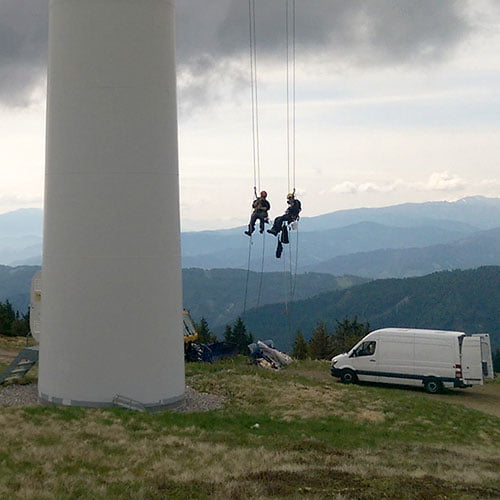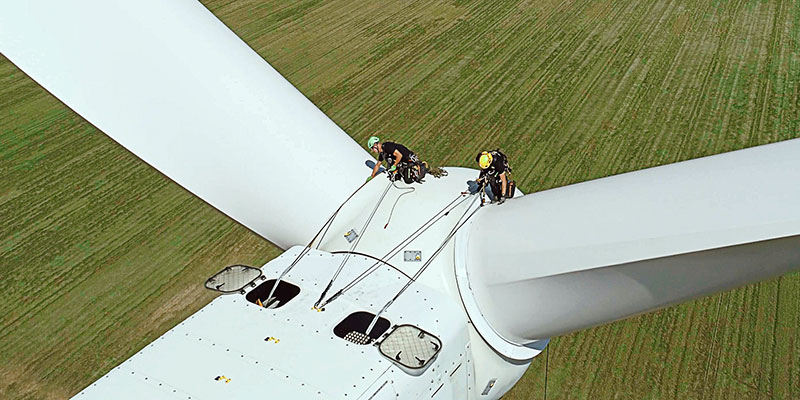May 2022
Rope access technicians Steven and Ricardo report from their everyday working life in rotor blade service
On the road with Steven and Ricardo, the two are a part of RTS history! They are 37 years old and have been very good friends for over 20 years. Steven is a trained metal worker and welder.
He got the idea that industrial climbing could be something for him through facade construction. He also “infected” Ricardo, who worked as an educator, with this. Together, the two got their start in offshore wind energy.
Ricardo
“The cool thing about the job is that I can use my head here every day to move the company forward. There is no routine and you don’t know what challenge is waiting the next week. That’s why I’m still at it 100% to this day.”

Steven
“For me, it’s not unusual to travel a few thousand kilometers a week across Europe … I can also fabulously combine my curiosity to travel to other countries (everyone knows them) with the necessary flexibility as a rope access technician … It’s really a great fit!”
How it all began:
What is special about the well-coordinated team is that they have been involved in the development of rotor blade service at RTS since the beginning in 2014:
Marvin Benker, now a member of the Management Board of RTS Wind AG, who took over the management of the new rotor blade project department in October 2013, received the first orders and the rope access team Steven and Ricardo carried them out at the wind farm. This sounds unexciting at first, but in reality it was a huge challenge for everyone. The task was to place RTS Wind AG on the market as a service provider in the rotor blade sector. Above all, the trust of the customers had to be won, and this can only be achieved through successfully completed orders and the resulting follow-up orders.
The situation demanded the highest level of commitment, flexibility and quality awareness from everyone involved.
The teams of the rotor blade project department started in 2014 from our RTS office in Austria. Here, the two FISAT Level 3 climbers worked for almost two years, carrying out orders from customers and training new rope access technicians bit by bit. It was not until the third year (2017) that the rotor blade unit in Austria was so well established that the team of two could return to Germany to work from here.
The variety of jobs at the wind farms excites both of them
Nacelle gluing, nacelle and tower cleaning, corrusion protection, surface work, floodlighting inspection, platform inspection, lightning protection measurement, blade component assembly and disassembly, repairs, and much more. All this is work that is carried out on the wind turbine “from the rope”. And this is only a small excerpt of the manual and mechanical work performed by the rope access technicians. A great help is the “rope moped” which works with an electronic winch and can be used to abseil down and – even more important – climb up the tower. This saves a lot of time and energy and is now used as standard at RTS.
The jobs take place all over Europe, a fact that both Steven and Ricardo appreciate, because they like to travel internationally.
Familiar team and new tasks
“The cooperation between the office and the technicians runs optimally in our department,” the two say. “It almost feels like family,” confirms Bilal Kaldirim, the current head of the rotor blade department.
In the course of the last eight years, a distribution of tasks has taken place: Ricardo is learning new colleagues in the rope and would like to go deeper into the area of HSE management and PSA testing in the future.
Steven is involved in site and team coordination, keeps an eye on the schedule and budget in particular, and also trains the rope access technicians on the “rope moped”. A good perspective for both of them and for RTS, because the bigger the department gets and the more teams are created, the more know-how is needed.

If you would like to be a part of the team, please feel free to apply at any time!
E-mail: jobs@rts-wind.de